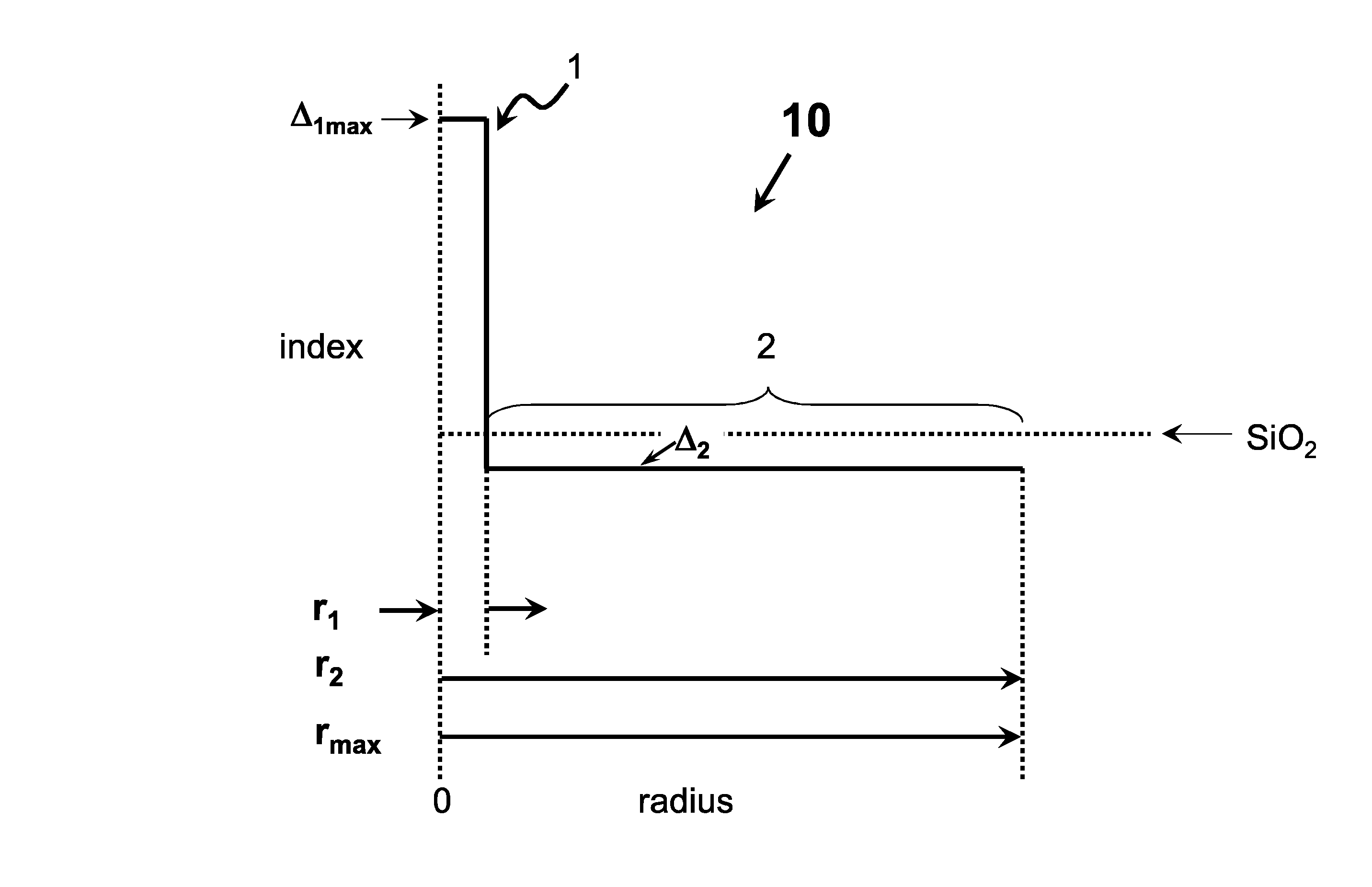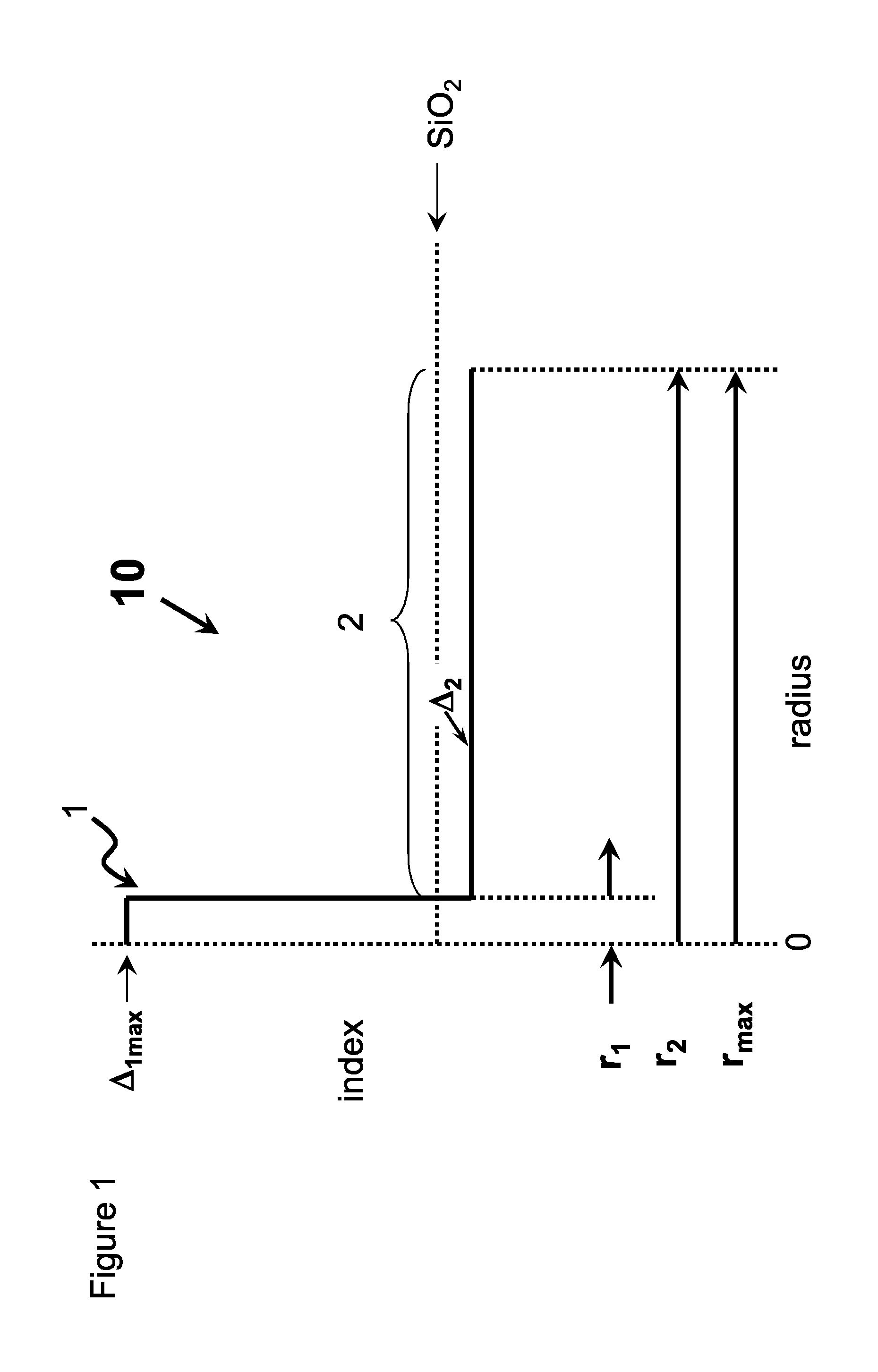High chlorine content low attenuation optical fiber
a low attenuation, optical fiber technology, applied in the field of optical fibers, can solve the problems of glass relaxation, high draw induced stress in the core region, high viscosity of optical fibers, etc., and achieve the effects of reducing fiber attenuation, reducing fiber stress, and reducing viscosity
- Summary
- Abstract
- Description
- Claims
- Application Information
AI Technical Summary
Benefits of technology
Problems solved by technology
Method used
Image
Examples
example 1
[0045]A 1 meter long 3000 gram silica soot preform having a density of about 0.5 g / cm3 was prepared in a lathe by flame depositing silica soot onto 10 mm diameter removable alumina rotating bait rod comprising a silica handle. The soot preform was placed into a consolidation furnace and dried at about 1225° C. in an atmosphere comprising about 55 volume percent helium and about 45 volume percent SiCl4. The assembly was then traversed (down-driven) through a hot zone having a peak temperature of about 1500° C. at a temperature ramp rate of about 2.5° C. / min, thus producing a fully densified Cl-doped silica glass core preform.
[0046]This preform was placed for about 24 hours in an argon purged holding oven set at 1000° C. in order to outgas dissolved helium in the glass. The preform was then placed in a redraw furnace set at about 1900° C., vacuum was applied through the handle to the centerline portion of the preform to collapse the hole in the centerline, and the preform was redrawn ...
example 2
[0047]A 1 meter long 3000 gram silica soot preform having a density of about 0.5 g / cm3 was prepared in a lathe by flame depositing silica soot onto 10 mm diameter removable alumina rotating bait rod comprising a silica handle. The alumina bait rod was removed creating an open centerline hole in the preform (which comprised a silica handle), then an 8.5 mm core cane (comprising a 1.8 wt % Cl-doped silica core from Example 1) was inserted into the centerline hole of the soot preform producing a core-cane soot preform assembly.
[0048]The core-cane soot preform assembly was placed into a consolidation furnace and dried at about 1200° C. in an atmosphere comprising helium and about 2.5 volume percent chlorine. Following this step, the soot of the preform assembly was doped with fluorine for 1 hour in an atmosphere comprising helium and about 1 volume percent SiF4; then under these flow rates, the assembly was then traversed (down-driven) through a hot zone having a peak temperature of abo...
example 3
[0050]A 1 meter long 16 mm diameter cane from Example 2 was placed on a lathe, then about 3100 grams of silica soot was flame deposited on the cane producing a cane-overclad preform assembly having an overclad soot density of about 0.5 g / cm3. This assembly was placed into a consolidation furnace and dried at about 1200° C. in an atmosphere comprising helium and about 2.5 volume percent chlorine Following this step, the assembly was doped with fluorine for 1 hour in an atmosphere comprising helium and about 1 volume percent SiF4; then under these flow rates, the assembly was then traversed (down-driven) through a hot zone having a peak temperature of about 1500° C. at a temperature ramp rate of about 2.5° C. / min to fluorine dope the silica soot and collapse the silica soot onto the core cane. This produced a fully densified void-free glass optical fiber preform having a Cl-doped silica core, a fluorine-doped silica cladding and fluorine-doped silica overcladding.
[0051]This preform wa...
PUM
| Property | Measurement | Unit |
|---|---|---|
| Temperature | aaaaa | aaaaa |
| Length | aaaaa | aaaaa |
| Percent by mass | aaaaa | aaaaa |
Abstract
Description
Claims
Application Information
 Login to View More
Login to View More - R&D
- Intellectual Property
- Life Sciences
- Materials
- Tech Scout
- Unparalleled Data Quality
- Higher Quality Content
- 60% Fewer Hallucinations
Browse by: Latest US Patents, China's latest patents, Technical Efficacy Thesaurus, Application Domain, Technology Topic, Popular Technical Reports.
© 2025 PatSnap. All rights reserved.Legal|Privacy policy|Modern Slavery Act Transparency Statement|Sitemap|About US| Contact US: help@patsnap.com



